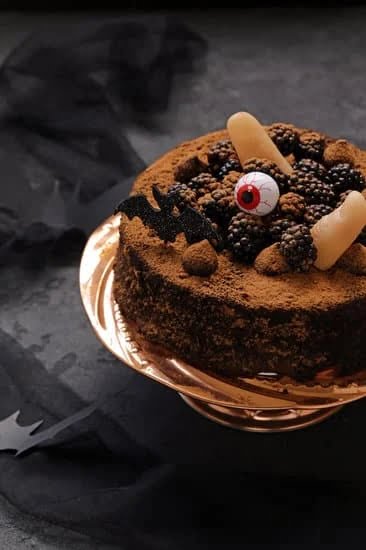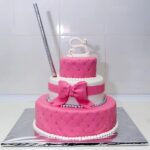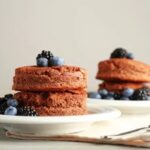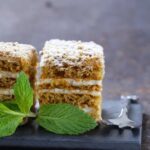Cake decorating has become an increasingly popular art form, captivating both professionals and amateurs alike. The combination of elegance, creativity, and the chance to indulge in delightful flavors is what makes cake decorating so enticing. Whether you’re a baking enthusiast or looking to start a new hobby, learning the basics of cake decorating is essential to create visually stunning and delicious treats.
At its core, cake decorating is a joyful and highly creative activity that allows individuals to unleash their imagination. From intricate designs to whimsical themes, the possibilities with cake decorating are endless. The process of transforming a plain cake into a work of art requires patience, precision, and attention to detail. Cake decorators have the opportunity to experiment with various techniques, shapes, colors, and textures that can showcase their unique style.
However, before diving into the world of cake decorating, it’s crucial to understand and master the basics. Learning the fundamentals will provide a strong foundation for more advanced techniques in the future.
The basics encompass essential skills such as frosting a cake evenly, creating smooth surfaces, selecting appropriate decorative elements, and understanding different icing options. By familiarizing yourself with these fundamental aspects of cake decorating, you will gain confidence in your abilities and be better equipped to tackle more complex designs.
In this article series, we will guide you through every aspect of cake decorating for beginners. From necessary equipment to mastering frosting techniques and exploring various decorative elements, we will cover everything you need to know to get started on your own creative journey. So grab your apron and let’s embark on this beautiful adventure where sugar meets artistry.
Essential Equipment for Cake Decorating
Cake decorating requires a few essential tools and equipment to create beautiful and professional-looking cakes. Whether you are a beginner or an experienced decorator, having the right equipment is crucial for achieving the desired results. Here are some must-have tools for cake decorating:
Piping Bags and Tips
One of the most important tools in cake decorating is a piping bag. Piping bags allow you to pipe different designs, patterns, and textures onto your cake. They come in various sizes and materials, such as disposable plastic or reusable fabric. Additionally, you will need a set of piping tips that attach to the end of the piping bag to create different shapes and designs.
Spatulas and Palette Knives
A palette knife or spatula is essential for spreading frosting smoothly and evenly on your cake. It helps achieve clean edges and smooth surfaces. Offset spatulas are particularly useful as they provide better control while spreading icing on hard-to-reach areas.
Turntable
A turntable is a revolving stand that allows you to easily rotate your cake while decorating it. It makes frosting the sides of the cake much more manageable by providing a smooth, continuous motion without needing to lift or move the cake.
Decorating Brushes
Decorating brushes are handy for adding intricate details or applying edible glitters or luster dust onto your cakes. It’s always good to have a variety of brush sizes to accommodate different design elements.
Molds and Cutters
Molds and cutters help create uniform shapes, figures, flowers, or other decorative elements with ease. Silicone molds are especially popular because they are flexible, making it easy to release fondant or gum paste decorations from them.
When choosing your cake decorating tools, it’s essential to consider quality as well as budget constraints. Investing in high-quality tools may cost more initially but will save you money in the long run, as they tend to last longer and provide better results.
Remember, having the right equipment is just one aspect of cake decorating. Continuous learning, practice, and experimentation are equally important in mastering this art form.
The Different Types of Icing for Cake Decorating
When it comes to cake decorating, one of the most important aspects to consider is the type of icing you will use. The icing not only adds flavor but also serves as a canvas for your creativity. There are several options available, each with its own unique properties and uses. In this section, we will explore the different types of icing commonly used in cake decorating.
Buttercream
Buttercream is perhaps the most popular type of icing for cake decorating. It is made by combining butter or shortening with powdered sugar and flavorings such as vanilla or cocoa. Buttercream icing is versatile and can be used for both filling and frosting cakes. It is smooth and creamy, making it easy to work with and achieve a polished finish. However, buttercream does not hold up well in warm temperatures and may require refrigeration.
Fondant
Fondant is a pliable icing that can be rolled out and draped over cakes to create a smooth canvas. It has a sweet taste and chewy texture that some find enjoyable. Fondant provides a clean, polished look to cakes and allows for intricate designs due to its flexibility. However, working with fondant can be challenging for beginners as it requires practice to get the right consistency and avoid air bubbles.
Royal Icing
Royal icing is a stiff icing made from powdered sugar, egg whites or meringue powder, and water. It hardens when dried, making it perfect for intricate details such as flowers or lacework on cakes. Royal icing can also be used for creating decorative pieces in advance as they dry hard enough to be handled without breaking. However, royal icing can be difficult to work with due to its quick drying time, so it requires precision and speed.
Ganache
Ganache is a luxurious icing made with chocolate and cream. It has a rich, velvety texture that adds elegance to any cake. Depending on the ratio of chocolate to cream, ganache can be used as both a filling and icing. It can be poured over cakes for a smooth glaze or whipped to create a fluffy texture. Ganache is versatile but may require refrigeration to set properly.
Each type of icing has its own pros and cons, which make them suitable for different cake decorating techniques and occasions. Experimenting with different icings will also help you develop your personal style as a cake decorator. In the next section, we will learn how to master the art of frosting, which is an essential skill in cake decorating.
Mastering the Art of Frosting
Frosting a cake is a fundamental skill in cake decorating that can make or break the final appearance of your creation. Whether you’re aiming for a smooth and sleek look or want to add texture and design with different frosting techniques, it’s important to know how to properly frost a cake.
In this section, we will provide you with a step-by-step guide on mastering the art of frosting, explore different frosting techniques, and offer troubleshooting tips for common frosting issues.
To start, it’s crucial to ensure that your cake is properly prepared before frosting. Make sure your cake layers are level by trimming any domed tops, and apply a crumb coat before adding the final layer of frosting. A crumb coat is a thin layer of frosting that helps seal in crumbs and provides a smooth surface for the final layer. Once your crumb coat is set, you can proceed with adding the final layer of frosting.
There are various frosting techniques you can use to achieve different effects on your cake. For those looking for a sleek and polished finish, the smooth technique is ideal. To achieve this look, start by applying a generous amount of frosting onto the top and sides of the cake.
Use an offset spatula or bench scraper to spread the frosting evenly across the cake while removing any excess. This technique requires patience and practice to achieve perfection but results in a professional-looking finish.
For those who prefer more textured designs, there are several techniques you can try. One popular method is creating rosettes using a piping bag fitted with a star tip. Start from the center of the cake and pipe small swirls with even pressure while rotating your hand clockwise or counterclockwise. Another technique is using different piping tips to create various shapes such as dots or borders around the edges of your cake.
Troubleshooting common frosting issues is also an essential part of mastering this skill. If you find that your frosting is too thick and not spreading easily, you can add a small amount of milk or cream to thin it out.
On the other hand, if your frosting is too thin and sliding off the cake, you can try refrigerating it for a few minutes to firm up before continuing to frost. Additionally, using a turntable while frosting can make the process smoother and easier.
Mastering the art of frosting takes practice and experimentation. It’s important to not get discouraged if your first attempts don’t turn out exactly as planned. With time and persistence, you will develop the skills needed to create beautifully frosted cakes. Keep in mind that every cake decorator has their own unique style, so don’t be afraid to experiment with different techniques and designs to find what works best for you.
| Frosting Technique | Purpose |
|---|---|
| Smooth Technique | To achieve a sleek and polished finish on the cake. |
| Rosettes | To create textured designs by piping swirls onto the cake. |
| Dots or Borders | To add decorative elements around the edges of the cake. |
Adding the Finishing Touches
When it comes to cake decorating, adding the finishing touches is where you can truly let your creativity shine. The use of decorative elements can transform a simple cake into a stunning masterpiece. In this section, we will explore various techniques and tools for incorporating these finishing touches onto your cakes.
One way to enhance your cake’s appearance is through the use of edible decorations. Edible decorations not only add visual appeal but also contribute to the overall flavor and texture of the cake. Sprinkles, candy, fresh fruit, and edible flowers are just a few examples of edible decorations that you can use.
To create intricate designs with icing, piping techniques are essential. These techniques allow you to add delicate details or bold patterns to your cakes. Piping bags and tips come in various sizes and shapes, each serving a different purpose. By experimenting with different tips and practicing piping techniques such as flowers or intricate borders, you can take your cake decorating skills to the next level.
Molds, stencils, and shaping tools are also valuable resources when it comes to adding decorative elements to cakes. Molds enable you to create intricate shapes and designs effortlessly, while stencils provide a guide for creating consistent patterns on your cakes. Shaping tools like silicone molds or fondant cutters allow you to sculpt figures or create three-dimensional decorations.
Incorporating decorative elements onto your cake requires patience and attention to detail. It’s important to practice each technique until you feel comfortable with it before attempting more complex designs. Remember that experimentation is key in developing your own unique style and flair in cake decorating.
Essential Decorating Techniques for Beginner Cake Decorators
Cake decorating is an art form that allows for creativity and expression. As a beginner cake decorator, it is essential to learn a few basic techniques that will set the foundation for your decorating journey. These techniques will help you achieve professional-looking cakes and build your confidence in creating beautiful designs. In this section, we will explore some essential decorating techniques for beginner cake decorators.
One of the most important decorating techniques to learn as a beginner is piping. Piping involves using a piping bag fitted with different tips to create various designs on your cake. Some common piping techniques include stars, dots, borders, and writing. To start piping, fill the piping bag with icing or buttercream and practice on a flat surface before moving onto your cake. Remember to apply even pressure while squeezing the bag to maintain consistent lines and shapes.
Another essential technique for beginner cake decorators is working with fondant. Fondant is a pliable icing that can be rolled out and draped over cakes to create smooth surfaces or shaped into intricate designs and figures.
To work with fondant, roll it out evenly using a rolling pin and use cornstarch or powdered sugar to prevent sticking. You can then cover your cake with fondant by carefully draping it over the top and sides while smoothing out any wrinkles or air bubbles.
Achieving even layers, sharp edges, and smooth surfaces on your cakes is also crucial in cake decorating. Leveling your cakes before stacking them ensures even layers for a professional finish. To achieve sharp edges on buttercream cakes, use an offset spatula or bench scraper to smooth the sides while holding it against the cake’s surface at an angle. For fondant-covered cakes, use a smoother tool to gently press against the surface and remove any imperfections.
| Decorating Technique | Description |
|---|---|
| Piping | Using a piping bag and tips to create various designs on the cake. |
| Fondant Work | Rolling out fondant, covering cakes, and creating intricate designs and figures. |
| Even Layers, Sharp Edges, and Smooth Surfaces | Leveling cakes, achieving sharp edges on buttercream, and smoothing fondant-covered cakes. |
Mastering these essential decorating techniques as a beginner cake decorator is essential for creating stunning cakes. With practice and patience, you will gain confidence in your skills and be able to take on more challenging designs. Remember to start with simple projects and gradually build up your expertise. The possibilities are limitless in cake decorating, so embrace the joy of learning new techniques and let your creativity shine.
Basic Cake Decorating Designs for Every Occasion
When it comes to cake decorating, having a variety of designs in your repertoire is essential for any occasion. Whether you’re baking a cake for a birthday party, wedding, or holiday celebration, knowing how to create different designs will elevate your cakes to the next level. In this section, we will introduce you to some basic cake decorating designs that you can use for every occasion.
- Layer Cakes: Layer cakes are a classic choice for birthdays and special occasions. To create a simple yet elegant design, consider using an ombre effect. This technique involves using shades of the same color to create a gradient on the cake.
Start by dividing your buttercream frosting into several bowls and adding food coloring incrementally to each bowl. Then, apply each shade of frosting onto the cake in horizontal lines and blend them together with a spatula or offset spatula. - Sheet Cakes: Sheet cakes are ideal for larger gatherings or when you need to feed a crowd. One popular design option for sheet cakes is creating stripes on the surface. Start by applying a thin layer of buttercream as the base coat, then use colored buttercream or fondant to pipe vertical or horizontal lines onto the cake. You can vary the thickness and colors of the stripes to create a fun and vibrant design.
- Cupcakes: Cupcakes are perfect individual treats that can be customized for any occasion. To add visual interest to your cupcakes, consider incorporating polka dot patterns using edible decorations like colored sprinkles or candies. After piping your buttercream onto each cupcake, gently press small round sprinkles or candy pearls into the frosting in various patterns and colors.
Remember that these designs are just starting points – feel free to experiment with different techniques and decoration ideas to make your cakes truly unique. And if you need inspiration or guidance along the way, there are many online resources such as tutorials and videos that can help you refine your skills even further. Happy decorating.
Troubleshooting and Common Mistakes in Cake Decorating
Cake decorating is a beautiful art form that allows for creativity and expression. However, it is not without its challenges. As a beginner cake decorator, you may find yourself facing common issues and making mistakes along the way. In this section, we will identify these common problems and provide tips on how to prevent and fix them.
One of the most common mistakes in cake decorating is uneven layers or lopsided cakes. This can happen if the cakes were not leveled properly before stacking or if the layers were not baked evenly. To prevent this issue, always level your cakes before stacking them by using a serrated knife or a cake leveler tool. Ensure that each layer of cake is of equal thickness for a professional-looking result.
Another common mistake is having air bubbles in your frosting or icing. These bubbles can ruin an otherwise smooth finish on your cake. To eliminate air bubbles, start by using a spatula to press out any air that may have been trapped during mixing. Additionally, give your frosting a gentle shake or tap on the counter to release any remaining air pockets.
One more frequent mistake is pastry bag leaking during piping designs on cakes. This can be caused by various factors such as overfilling the bag, using low-quality bags or couplers, or applying too much pressure while piping. To avoid this problem, make sure not to fill the pastry bag more than two-thirds full to allow room for proper control and grip. Additionally, invest in high-quality pastry bags and couplers that are less prone to leaking.
By being aware of these common mistakes and following these tips for prevention and solution, you can overcome frustrations and achieve better results in your cake decorating journey. Remember that practice makes perfect in this art form, so don’t get discouraged if you encounter difficulties along the way. In the next section, we will provide further guidance on basic cake decorating designs for every occasion, enhancing your creative skills and allowing you to showcase your talent.
Conclusion
In conclusion, cake decorating is a beautiful art form that has gained popularity in recent years due to its joyous and creative nature. Learning the basics of cake decorating is essential for anyone interested in immersing themselves in this craft. Throughout this article, we have explored the essential equipment needed for cake decorating, the different types of icing to use, mastering frosting techniques, adding decorative elements, essential techniques for beginners, basic cake designs for every occasion, and troubleshooting common mistakes.
We have covered a range of topics and provided step-by-step guides and tips to help you get started on your cake decorating journey. However, it’s important to remember that this is just the beginning. Practice and experimentation are key in becoming proficient in this art form. By continually honing your skills and pushing your boundaries, you will be able to create stunning cakes that will impress friends, family, and clients.
If you’re looking to learn more about cake decorating or take your skills to the next level, there are numerous resources available. Consider enrolling in a local cake decorating class or joining an online community where you can connect with other enthusiasts and professionals who can offer guidance and support. Additionally, there are many websites, books, and tutorials available that provide further education and inspiration.
Remember, Rome wasn’t built in a day and neither will be your masterpiece cake creations. Embrace the journey of learning and growing as a cake decorator. With time and dedication, you will surprise yourself with how far you’ve come and the stunning creations you can bring to life. So roll up your sleeves, grab your tools, and let your creativity take flight as you embark on this exciting adventure of cake decorating.
Frequently Asked Questions
What are the principles of cake decorating?
The principles of cake decorating involve several key aspects that contribute to creating a visually appealing and delicious cake. Firstly, color plays a vital role in cake decoration. A harmonious color scheme can enhance the overall appearance of a cake, while contrasting colors can create visual interest. Secondly, texture is important in adding depth and dimension to the cake.
Creating smooth surfaces or incorporating various patterns and designs with different tools can significantly enhance the overall appearance. Thirdly, balance is crucial in cake decorating to ensure that all elements are proportionately distributed, avoiding any overcrowding or imbalance. Lastly, creativity and attention to detail are essential principles as they allow decorators to think outside the box and add personalized touches to emphasize themes or styles.
What are the 7 different cake decorating techniques?
There are seven common techniques used in cake decorating that allow decorators to achieve various effects and designs on their cakes. First is piping, which involves using a pastry bag fitted with different tips to create elaborate borders, writing, or intricate designs with frosting or icing. Second is fondant decoration, where a pliable sugar paste called fondant is rolled out and used to cover the entire cake or create decorations like flowers and shapes that can be molded onto the surface. Third is stenciling, which uses specially designed templates placed over the cake to create intricate patterns by dusting powdered sugar or cocoa powder onto the exposed areas of the cake through the stencil openings.
Fourth is airbrushing, where food-grade colored paints are sprayed onto the cake using an airbrush for achieving smooth gradients or vibrant hues. Fifth is painting directly on cakes using edible food colors mixed with alcohol or water to create detailed designs freehand. Sixth is sculpting 3D figures from fondant or modeling chocolate to create lifelike representations such as animals, people, or objects from scratch. Lastly is carving and shaping cakes into desired forms like characters, objects, or intricate structures using specialized tools.
What are the three essentials of cake decorating?
The three essentials of cake decorating are a sturdy cake base, a good icing or frosting, and appropriate tools. Firstly, a sturdy cake base is crucial to provide structural support for the cake layers above it. Choosing a dense and moist cake with the right firmness can ensure that the overall cake remains stable and doesn’t collapse under the weight of decorations. Secondly, a good icing or frosting is essential for both flavor and decoration purposes.
The chosen icing should be spreadable yet sturdy enough to hold up the decorations while also complementing the flavor profile of the cake. Different types of icings like buttercream, whipped cream, ganache, or fondant can be used depending on personal preferences and design requirements. Lastly, having appropriate tools is vital to execute various decorating techniques effectively. Common tools include spatulas for spreading icing or smoothing surfaces, piping bags and tips for detailed designs, fondant smoothers for achieving a sleek finish, brushes for painting or dusting colors onto cakes, and specialized cutters or sculpting tools for creating intricate shapes or figures.

Welcome to our cake decorating blog! My name is Destiny Flores, and I am the proud owner of a cake decorating business named Cake Karma. Our mission is to provide delicious, beautiful cakes for all occasions. We specialize in creating custom cakes that are tailored specifically to each customer’s individual needs and tastes.





